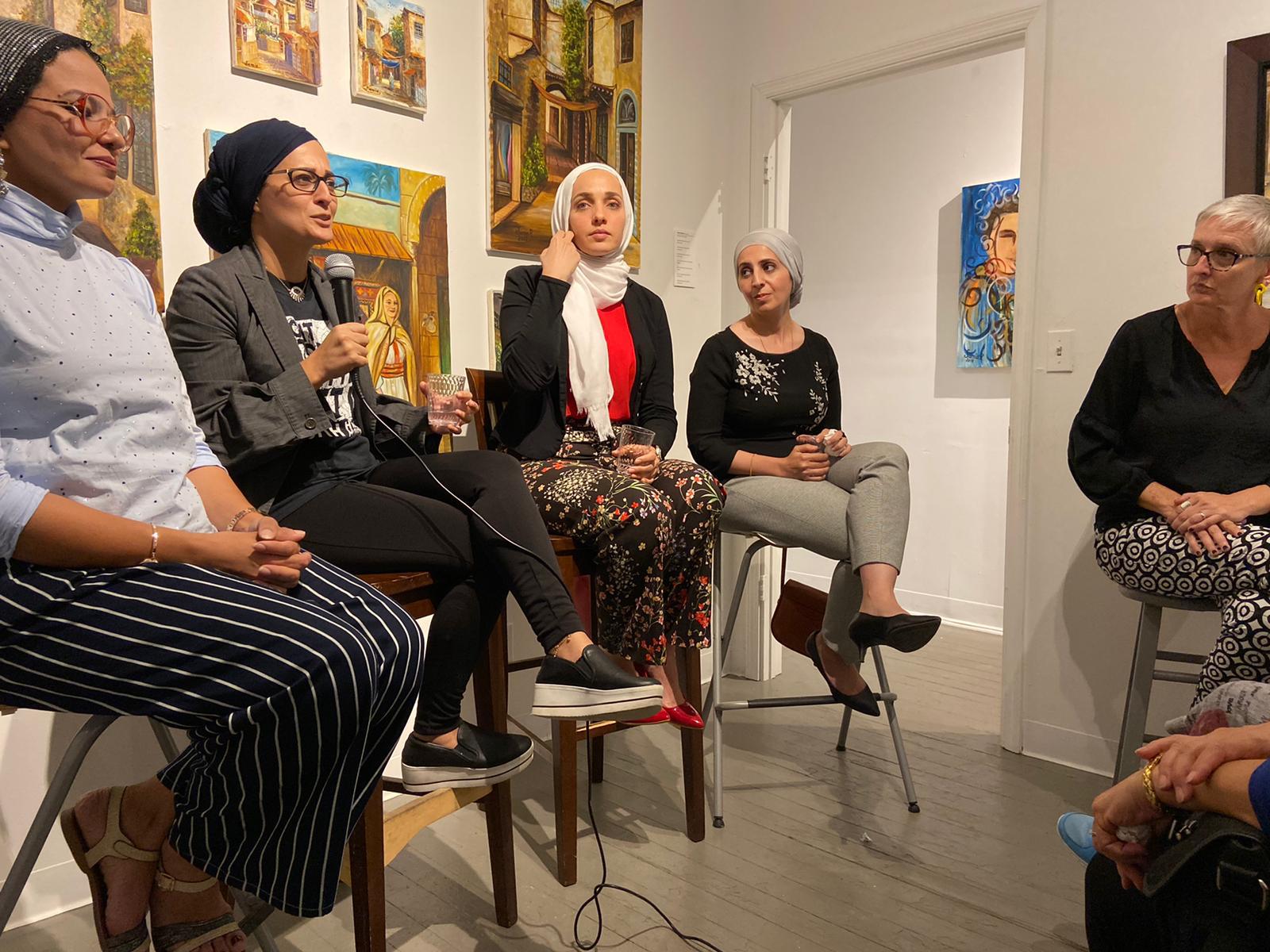Written by Hope McMath
On the surface it was an exhibition highlighting the art and stories of 15 women from Iraq, Syria, Palestine, and Egypt. But Home: The Stories of Arab Women Immigrants and Refugees evolved into a transformational experience for the participating artists, community members, and the those of us closely engaged in the work of Yellow House.
How does one measure this concept of ‘transformation’ in an era of data and detailed assessment? We could simply land on the numbers and report that the attendance during the exhibition and related programs was the highest in our 27 months of existence. We could have sent out survey tools to the students, physicians, parents, and community members who attended to capture changed attitudes or facts learned.
Instead we are sharing impact through stories. And although it is impossible in this space to share the fullness of each experience or the true breadth and depth of the conversations that occurred everyday, we share here a few memorable moments to honor the women we had the pleasure to work with and all who were witness to the exhibition’s power.
The fact that the women in the exhibition courageously shared their own journeys, through words, portraits, and art, seemed to give permission to others to do the same. It happened everyday we were open. Veterans from the war in Iraq shared the dissonance and grief they felt reading the statistics of lost and displaced lives while remembering their own experiences on the ground in a country they knew little about. A high school student engaged in conversation with one of the artists about the meaning of wearing a hijab and freely admitted that she had been taught to fear those donning a headscarf. A Civil Rights leader felt deeply connected to the artists she met, understanding the similarity in their struggles. She made us all stand up a little straighter with her pronouncement of her new-found solidarity with immigrant and refugee women in our community.
Sometimes the learning happened while joyfully dancing together or breaking bread, sharing the sweetness of baklava and the rich savoriness of dolma. And sometimes understanding was built through art making, led by the women as a cultural exchange with people who had never worn henna on their skin, sculpted a flower from paper, or crocheted a bracelet like those that occupied Sedra’s childhood in a displacement camp on the border of Jordan. And on the regular, teachable moments occurred through tears.
Many of the human connections forged during the run of the exhibition were the result of discovering similarities in lived experiences: caring for children, missing family living far away, integrating into new communities, isolation, solidarity, the need to feel welcome, the importance of feeling safe. But just as often there was a strong understanding of the unique challenges and courage that the artists in the exhibition faced…as women, as refugees and immigrants, as women of color, as arabic speakers, and as people fleeing war to find safety in a place often engaged in the conflicts that drove them from their homes. And these differences were given space, acknowledged and celebrated by centering their voices on the walls, during artist talks, story slams, family days, and quiet one-on-one visits.
The exhibition’s co-curators Malath Alarnosi, Basma Alawee and myself were determined to create a space where people could not only learn, but actually engage in the real work of creating open and inclusive communities. We asked visitors to commit to taking action and to reject the harmful xenophobic rhetoric and policies marking this moment in our shared histories. And sometimes it was the visitors doing the asking. This happened most recently during a workshop with physicians who were using the exhibition as a tool to build cultural competency. One participating doctor, who was born in Iraq and came here as a child, implored his peers to be vigilant, to vote with the lives of refugees in mind, and to understand the real risks lived by those still trying to find ‘home’.
My own experience was profound. From our first moments together, these women became co-conspirators committed to speaking truth, leading change, and sharing love. They have now become friends, the kind you open your homes and hearts to. Most importantly, my own biases were checked and much knowledge was gained.
Yes, most of my favorite moments included the food we shared on the regular, but I was most moved by the times when the remarkable strength and tenacity of the women was most evident. I will never forget Ban’s quiet determination to converse with visitors, even when surrounded by dark images of chaos and the sound of sirens. Or Safaa’s decision to allow her photograph to be in the exhibition, overcoming the fear of being truly seen. Or Samya’s excitement when seeing her art on the wall of a gallery for the first time since coming to this country from Syria. Or the rally we had with nearly 100 members of the Iraqi community in the first days of the demonstrations and violence happening on the streets of Baghdad as demands for change bubbled over.
I doubt I will forget Alaa bringing her eight year old twin daughters over and over again to Yellow House where they became our best docents, transferring their intellect, creativity, and hope to dozens of visitors. And watching Noor tell her story from a stage to a room of strangers for the first time was an inspiration. I remain grateful for my first meal with Basma and Malath when we committed to doing this work together and for the opportunity to watch them both raise their activist voices in the pouring rain to send a message heard around the world. And I will never forget witnessing Malath slowly stitching together a tent that served as a symbol for so much that is wrong in this world, and doing so from a place of radical love.
My hope is that this exhibition and the broader experiences that wrapped around it brought others a greater understanding of the concept of home and what it really means to love our neighbors. The women in this show certainly reminded me that each of us has the opportunity to change the world, not with bombs, but with truth, a commitment to deep understanding of one another, and a strong cup of tea made and shared in love


